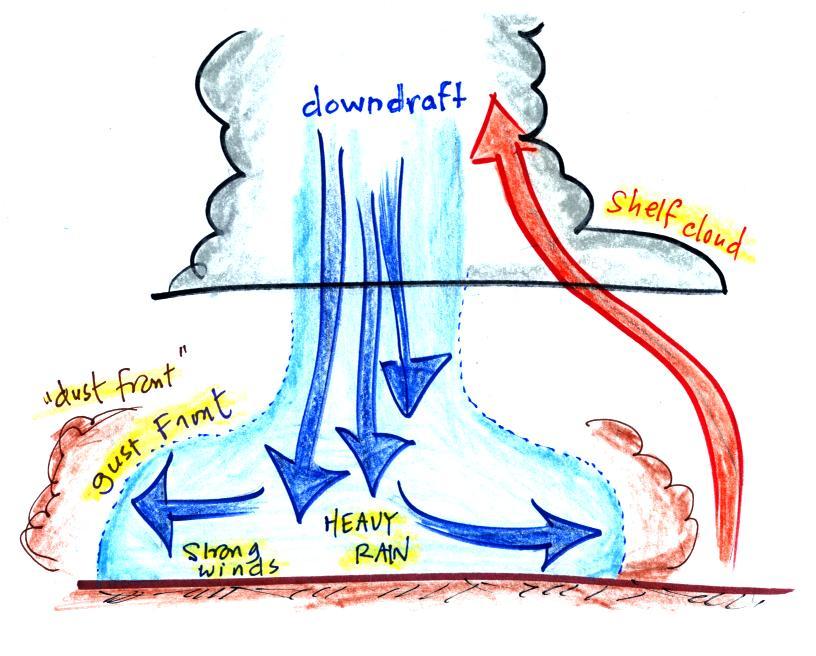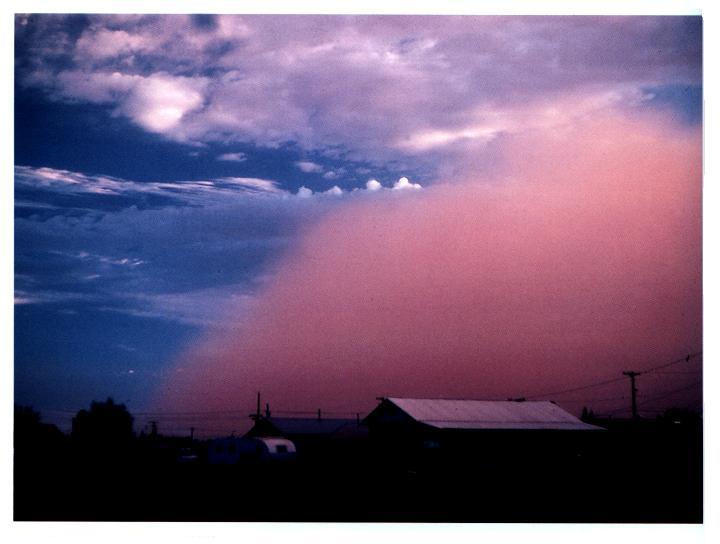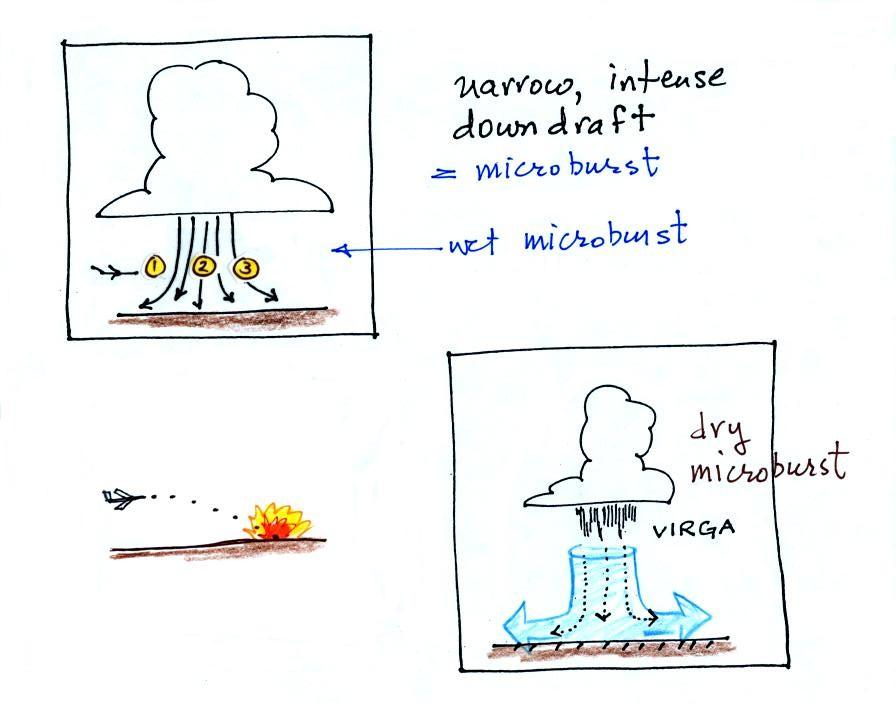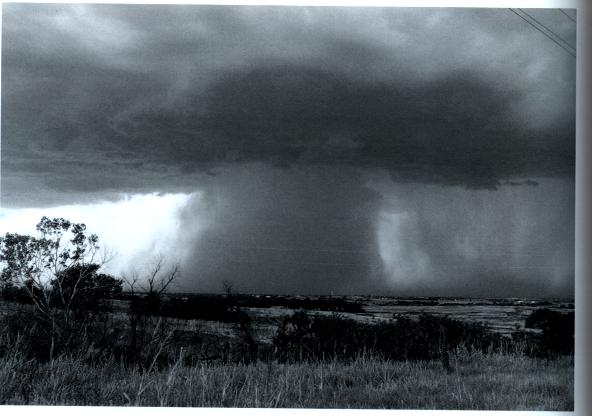Wednesday - Thunderstorms pt. 2, Tornadoes pt. 1
Friday - Tornadoes pt. 2
Monday - Lightning
Today and part of Wednesday
will be devoted to thunderstorms. Here's a little bit of
an introduction (found on p. 150 in the ClassNotes)
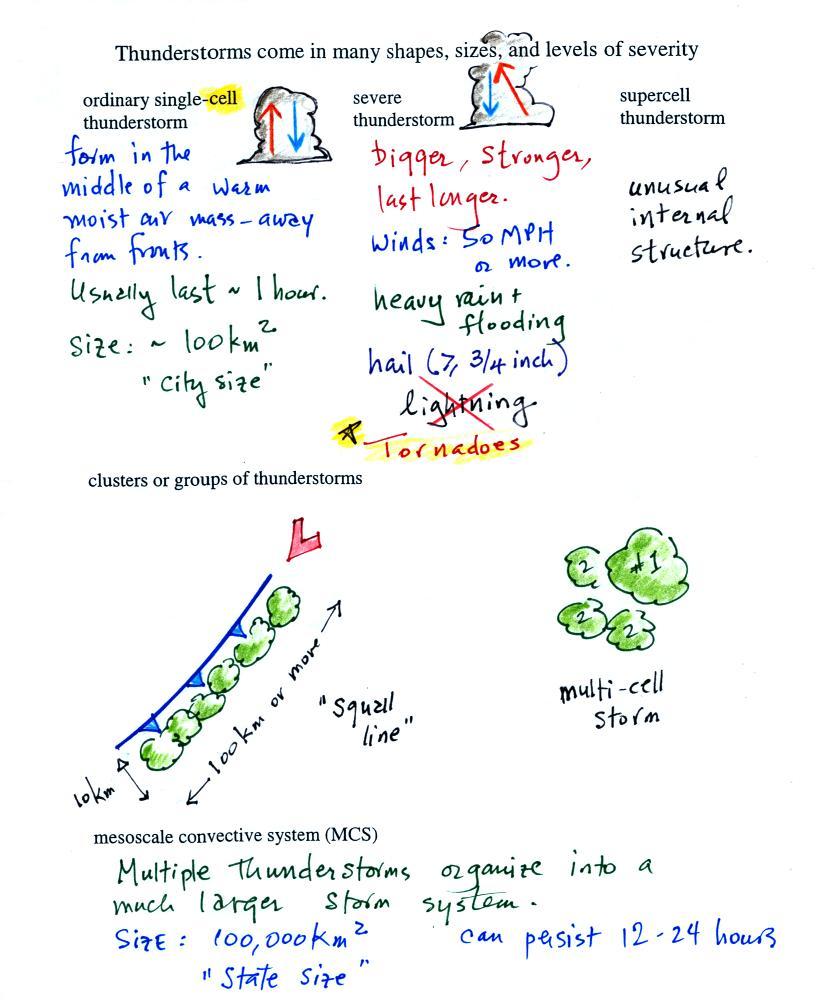
Tilted updrafts are found in severe and supercell thunderstorms. As we shall see this allows those storms to get bigger, stronger, and last longer. The tilted updraft will sometimes begin to rotate. We'll see this produces an interesting cloud feature called a wall cloud and maybe tornadoes. Supercell thunderstorms have a complex internal structure; we'll watch a short video at some point that shows a computer simulation of the complex air motions inside a supercell thunderstorm.
We won't spend anytime discussing mesoscale convective systems except to say that they are a much larger storm system. They can cover a large portion of a state. They move slowly and often thunderstorm activity can persist for much of a day. Occasionally in the summer in Tucson we'll have activity that lasts throughout the night. This is often caused by an MCS.
The following somewhat tedious material was intended to prepare you to better appreciate a time lapse video movie of a thunderstorm developing over the Catalina mountains. I don't expect you to remember all of the details given below. The figures below are more carefully drawn versions of what was done in class.
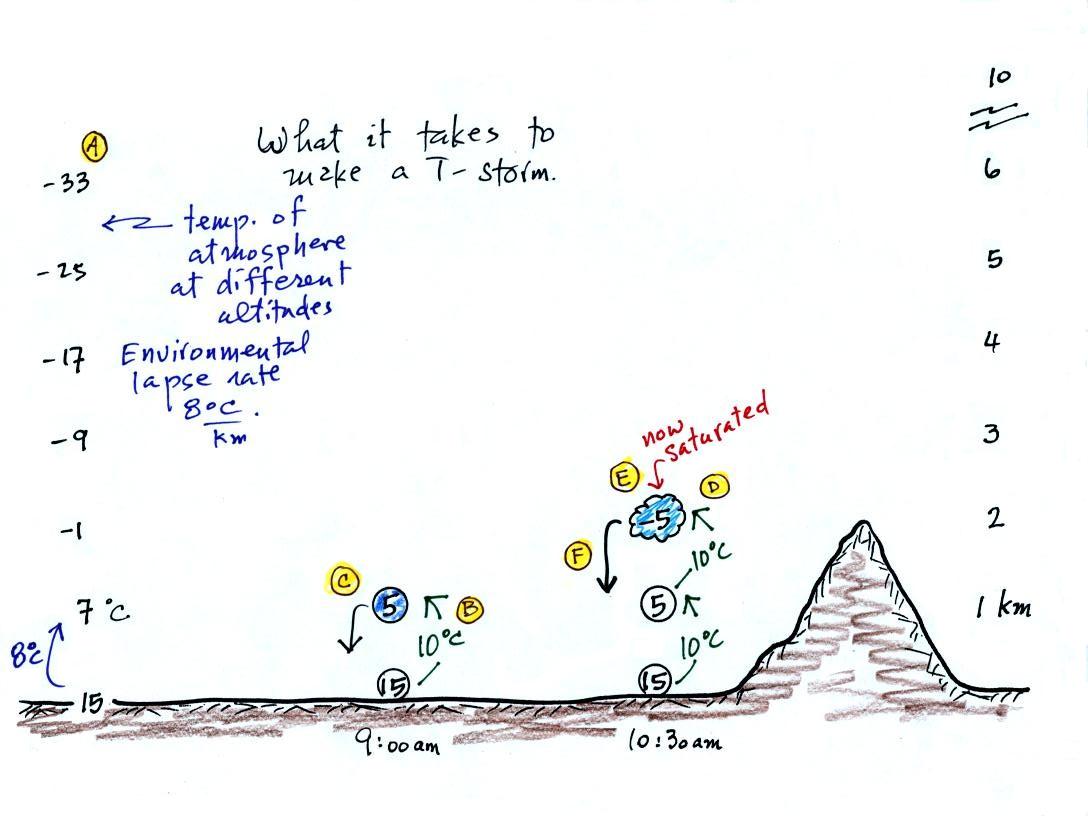
Refer back and forth between the lettered points in the figure above and the commentary below.
The numbers in Column A show the temperature of the air in the atmosphere at various altitudes above the ground (note the altitude scale on the right edge of the figure). On this particular day the air temperature was decreasing at a rate of 8 C per kilometer. This rate of decrease is referred to as the environmental lapse rate (lapse rate just means rate of decrease with altitude). Temperature could decrease more quickly than shown here or less rapidly. Temperature in the atmosphere can even increase with increasing altitude (a temperature inversion).
At Point B, some of the surface air is put into an imaginary container, a parcel. Then a meteorological process of some kind lifts the air to 1 km altitude (in Arizona in the summer, sunlight heats the ground and air in contact with the ground, the warm air becomes buoyant - that's called free convection). The rising air will expand and cool as it is rising. Unsaturated (RH is less than 100%) air cools at a rate of 10 C per kilometer. So the 15 C surface air will have a temperature of 5 C once it arrives at 1 km altitude.
Early in the morning "Mother Nature" is only able to lift the parcel to 1 km and "then lets go." At Point C note that the air inside the parcel is slightly colder than the air outside (5 C inside versus 7 C outside). The air inside the parcel will be denser than the air outside and the parcel will sink back to the ground.
By 10:30 am the parcel is being lifted to 2 km as shown at Point D. It is still cooling 10 C for every kilometer of altitude gain. At 2 km, at Point E the air has cooled to its dew point temperature and a cloud has formed. Notice at Point F, the air in the parcel or in the cloud (-5 C) is still colder and denser than the surrounding air (-1 C), so the air will sink back to the ground and the cloud will disappear. Still no thunderstorm at this point.
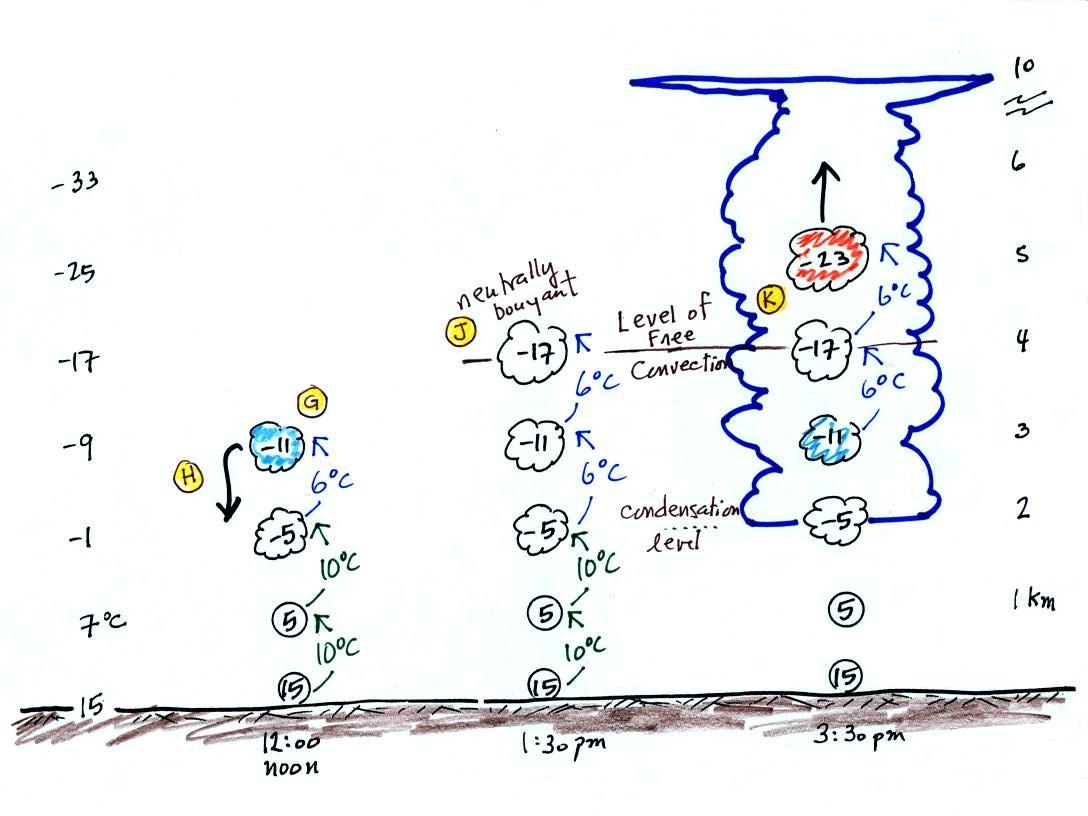
At noon, the air is lifted to 3 km. Because the air became saturated at 2 km, it will cool at a different rate between 2 and 3 km altitude. It cools at a rate of 6 C/km instead of 10 C/km. The saturated air cools more slowly because release of latent heat during condensation offsets some of the cooling due to expansion. The air that arrives at 3km, Point H, is again still colder than the surrounding air and will sink back down to the surface.
By 1:30 pm the air is getting high enough that it has become neutrally bouyant, it has the same temperature and density as the air around it (-17 C inside and -17 C outside). This is called the level of free convection, Point J in the figure.
If you can, somehow or another, lift air above the level of free convection it will find itself warmer and less dense than the surrounding air as shown at Point K and will float upward to the top of the troposphere on its own. This is really the beginning of a thunderstorm. The thunderstorm will grow upward until it reaches very stable air at the bottom of the stratosphere.
This was followed by a time lapse video tape of actual thunderstorm formation and growth. I don't have a digital version of that tape, so here is a substitute time lapse of a day's worth of thunderstorm develop
The events leading up to the initiation of a summer air mass thunderstorm are summarized in the figure below. It takes some effort and often a good part of the day before a thunderstorm forms. The air must be lifted to just above the level of free convection (the dotted line at middle left in the picture). Once air is lifted above the level of free convection it finds itself warmer and less dense that the air around it and floats upward on its own. I've tried to show this with colors below. Cool colors below the level of free convection because the air in the lifted parcel is colder and denser than its surroundings. Warm colors above the dotted line indicate parcel air that is warmer and less dense than the surroundings. Once the parcel is lifted above the level of free convection it becomes buoyant; this is the moment at which the air mass thunderstorm begins.
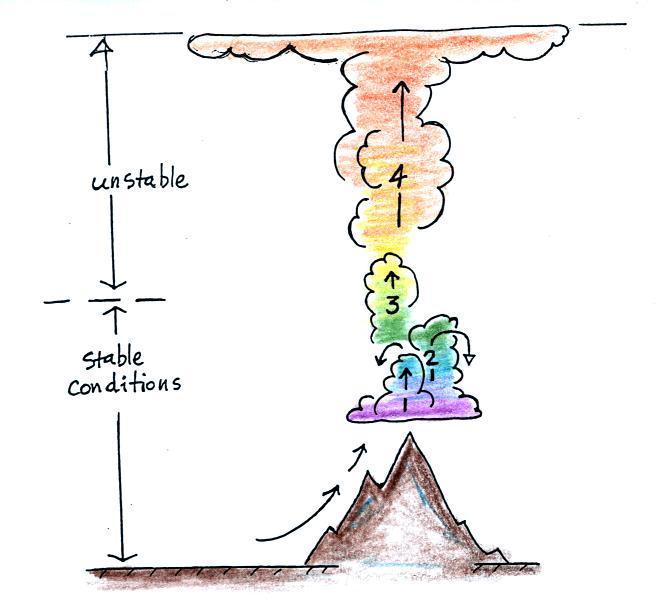
Once a thunderstorm develops it then goes through a 3-stage life cycle

In
the first stage you would only find updrafts inside the
cloud (that's all you need to know about this stage, you
don't even need to remember the name of the stage).

Once precipitation has formed and grown to a certain size,
it will begin to fall and drag air downward with it.
This is the beginning of the mature stage where you find
both an updraft and a downdraft inside the cloud. The
falling precipitation will also pull in dry air from outside
the thunderstorm (this is called entrainment).
Precipitation will mix with this drier air and
evaporate. The evaporation will strengthen the
downdraft (the evaporation cools the air and makes it more dense). The thunderstorm
is strongest in the mature stage. This is when the
heaviest rain, strongest winds, and most of the lightning
occur.
Eventually the downdraft spreads horizontally throughout the inside of the cloud and begins to interfere with the updraft. This marks the beginning of the end for this thunderstorm.
Eventually the downdraft spreads horizontally throughout the inside of the cloud and begins to interfere with the updraft. This marks the beginning of the end for this thunderstorm.

The
downdraft
eventually fills the interior of the cloud. In this
dissipating stage you would only find weak downdrafts throughout the cloud.
Note how the winds from one thunderstorm can cause a region of convergence on one side of the original storm and can lead to the development of new storms. Preexisting winds refers to winds that were blowing before the thunderstorm formed. Convergence between the prexisting and the thunderstorm downdraft winds creates rising air that can initiate a new thunderstorm.
The picture below shows some of the features at the base of a
thunderstorm.Note how the winds from one thunderstorm can cause a region of convergence on one side of the original storm and can lead to the development of new storms. Preexisting winds refers to winds that were blowing before the thunderstorm formed. Convergence between the prexisting and the thunderstorm downdraft winds creates rising air that can initiate a new thunderstorm.
